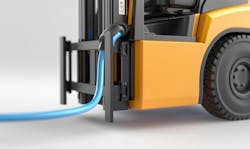Why the Second-Life Forklift Battery Market is Stalling
What you'll learn:
- The missed opportunity with forklift batteries.
- The price dilemma in the second-life battery market.
- Logistical and operational roadblocks to battery reuse.
- Why the U.S. is behind Asia and Europe in battery reuse.
- Steps toward a brighter future in reusing batteries.
The movement toward electric vehicles in many applications is driven by commercial gains.
Along these lines, the electrification of forklift fleets is contributing to a boom in lithium-ion battery production. However, about 10% to 15% of these new batteries never get used in their intended applications, often due to overproduction or canceled projects.
While recycling is important for end-of-life batteries, repurposing these lightly used or surplus batteries for second-life applications—like energy storage of e-mobility—could bring significant environmental and economic benefits.
Unfortunately, the second-life battery market, especially in industrial applications like forklifts, isn’t growing as it could. Let’s explore the challenges holding this market back and what can be done to turn things around.
The Missed Opportunity with Forklift Batteries
The elephant in the room: Many lithium-ion batteries from forklifts that could still be functional (often with a state of health over 80%) are sent to recycling instead of being reused. This includes surplus batteries from manufacturers and lightly used batteries. While these surplus batteries can offer a cheaper alternative to new ones, they often don’t get considered for reuse because:
- Lack of warranty: Buyers prefer new batteries that come with warranties.
- Logistical hurdles: The process of collecting and shipping these batteries add to the resale price.
- Testing needs: Batteries require testing to ensure that they’re safe and effective, which can be costly.
Despite being less expensive, surplus batteries are often overlooked for new ones, leaving a lot of potential untapped. Utilizing these batteries could reduce waste and lower the carbon footprint tied to manufacturing new battery cells.
Economic Challenges: The Price Dilemma
The down trend in prices of new lithium-ion batteries pose a significant challenge for the second-life market (see figure).
In 2024, prices in China fell to as low as $30–50 per kWh due to:
- Oversupply: Rapid growth in battery production has outpaced demand, leading to fierce competition.
- New technologies: Cheaper battery types, like lithium iron phosphate (LFP), are becoming mainstream.
- Maturing manufacturing: Innovations have made new batteries competitive in price with second-life options.
As a result, buyers often opt for new batteries with warranties and the latest technology, leaving second-life batteries struggling to gain traction. Sellers, on the other hand, just do what’s easy—sending all retired batteries to recycling, indiscriminately of a battery condition.
Logistical and Operational Roadblocks to Battery Reuse
Repurposing forklift batteries comes with its own challenges:
- Testing and certification: Ensuring safety requires thorough testing, which can be expensive and time-consuming, especially with large quantities.
- Regulatory compliance: Handling batteries involves complex regulations, which can deter forklift dealers from getting involved in battery logistics.
- Lack of standardization: Without standardized testing and grading processes, transactions become complicated and discourage both sellers and buyers.
In addition, owners looking to sell retired batteries face substantial shipping costs. Cross-country shipments can be $5,000–$6,000, and international shipping often requires more legal work and special packaging.
Why the U.S. is Behind Asia and Europe in Battery Reuse
The U.S. second-life battery market isn’t as developed as those in Asia and Europe, where infrastructure and financing on the second-life battery market are better established. In Europe, companies have adopted battery digital passports to simplify testing and reduce costs. In Asia, the demand for cheap energy storage and the development of swappable EV battery technology is driving the use of retired but healthy batteries.
In the U.S., there’s a disconnect between first-life battery owners and second-life buyers. First-life owners expect to recover 50% or more of their battery's original value, while second-life companies can typically afford to pay only 10% to 20%. This gap creates a mismatch that complicates transactions.
Steps Toward a Brighter Future in Reusing Batteries
Despite these hurdles, there’s great potential for the second-life battery market to thrive, especially in the forklift sector. Repurposing batteries can extend their lifespan, reduce waste, and ease the environmental burden of new battery production. Second-life batteries are able to provide cost-effective energy storage and contribute to the electrification of industrial operations.
To unlock this potential, several actions can be taken:
- Standardization: Streamlining testing and grading processes will reduce inefficiencies and costs.
- Design for reuse: Creating batteries that are easier to disassemble and include accessible data will facilitate easier reuse.
- Raising awareness: Educating first-life owners about the benefits of second-life batteries can shift market behavior and help mitigate legal concerns.
The second-life battery market holds significant promise for reducing waste and promoting sustainability in the material-handling equipment sector, particularly for forklifts. However, overcoming the barriers—such as pricing issues and logistical challenges—will require collaboration and innovative solutions from all stakeholders involved. By working together, we can create a more sustainable future for battery use in industrial applications.
About the Author

Maxim Khabur
Director of Marketing, Bluewater
Maxim Khabur is director of marketing at Bluewater, a battery lifecycle management company. He also serves as chairman of the Advanced Energy Council, which represents a group of 20-plus companies working in the area of advanced energy technologies who are also members of MHI.org (Materials Handling Industry Association).

